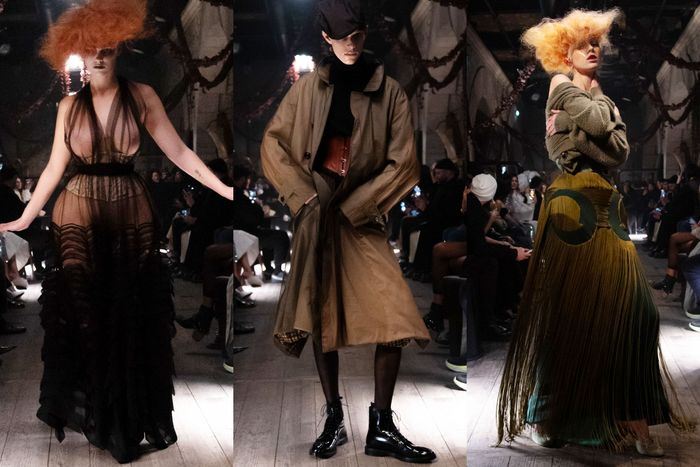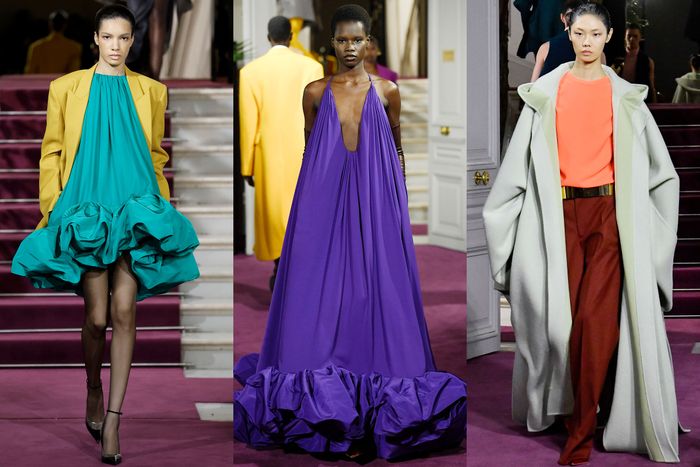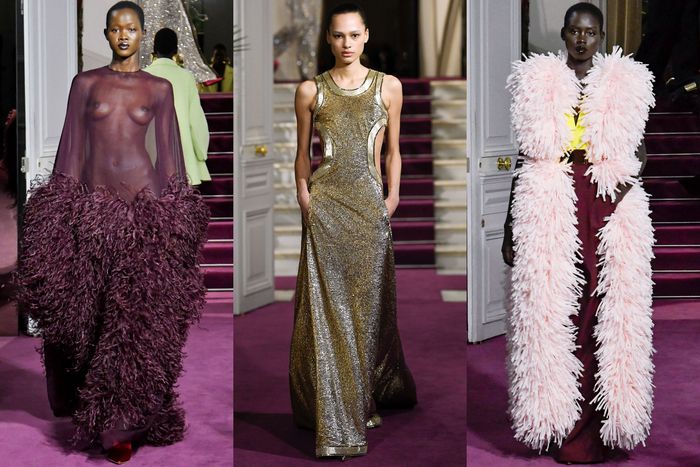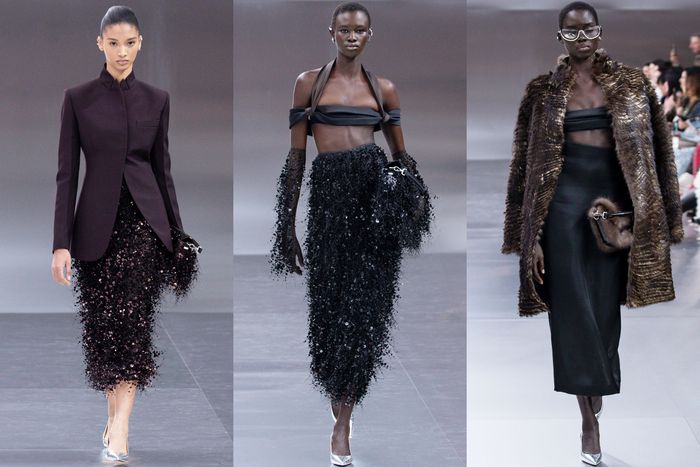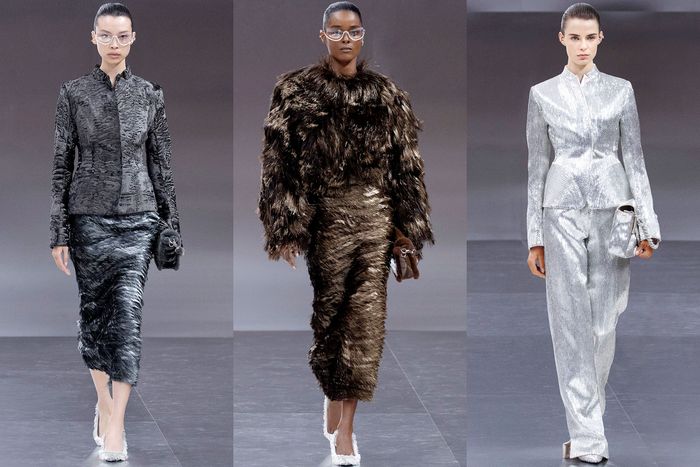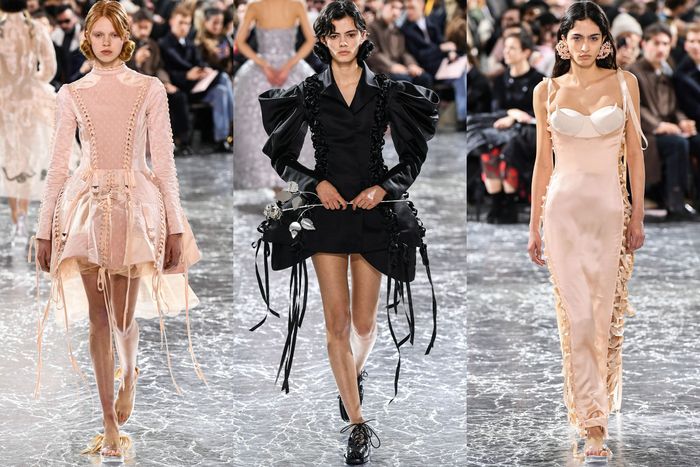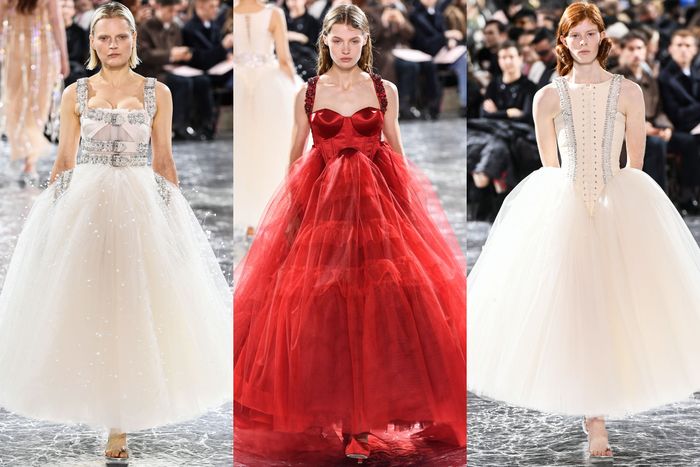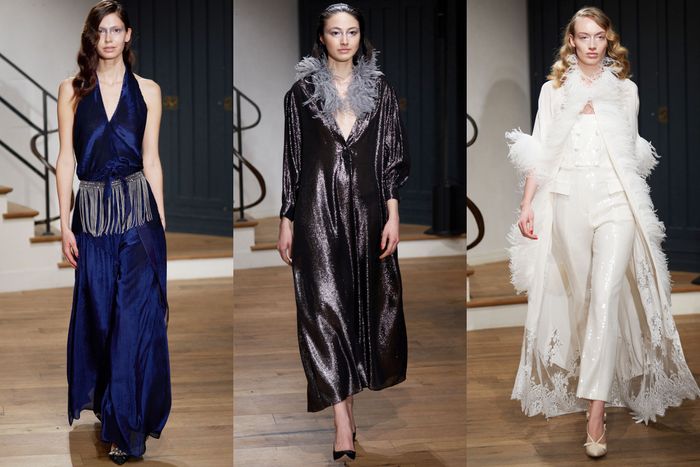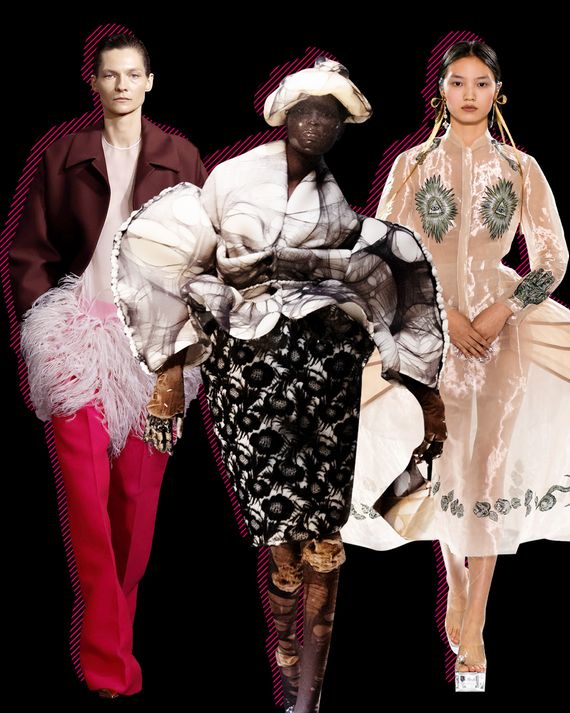
John Galliano could not have conjured a more Brassaï-like Parisian night if he had tried, for he had the luck of a sudden rain shower and then a light mist. It turned wet the steps leading to the quai along the Seine and the stone chamber under the Pont Alexandre III, where his Maison Margiela show took place on Thursday. A huge light, on a boom, heightened the ghostly glow of the pavement and the water, what Brassaï in the 1930s achieved with long exposures and later flashbulbs. There were a number of café tables arranged outside in the shadows of the bridge arches and inside the chamber was a bar heaped with dirty dishes and glasses. Symbolically, it was 3 a.m.
Using the city’s architecture, its parks, cafés, and bordellos as his stage, Brassaï’s photographed prostitutes, pimps, hoodlums, the down-and-out, cross-dressers, and “assorted cold-eyed pleasure-seekers,” as John Szarkowski, the late director of photography at New York’s Museum of Modern Art, put it. Born Gyula Halász in Hungary in 1899, Brassaï later worked for Harper’s Bazaar from 1936 to 1963.
But it was his portraits of Paris in the illicit, dirty ’30s that captivated Galliano and which, almost incredibly, he evoked. Not only did the models’ clothes, hair and makeup seem at times as grainy and blurry as a Brassaï nighttime image, but also, as a guest in Galliano’s recreated cabaret, I felt part of the image myself. Which was surely Galliano’s intention. He has not shown couture since July 2022, when he created a multilayered production around the making of a movie about young lovers on the run.
And it was clear from this new show that he and his team spent months and months on the details: the frowzy wigs; the porcelain doll-like makeup; the authentic corsets; the dirty gauze bandages that appeared around one model’s knees; the merkins that others wore to show exposed pubic hair under sheer black skirts; the choreography of the models, some of whom moved like gazelles while other lumbered like truck drivers; the black-and-white film that played at the start and the live performance by a handsome one-armed singer and the tiny bunches of fresh violets on the tables that nurtured the dream of a stylish life.
This show belongs with the greatest Galliano collections, including the 1994 ready-to-wear show at Sao Schlumberger’s former house in Paris, and the so-called “hobo collection” for Dior haute couture in 2000, that caused a bit of a scandal. I could mention others. In many ways, the new collection goes further — emotionally, visually, psychologically — than any other. One reason is that the clothing itself is relatively simple. There are gorgeous black sheer dresses with draping and embroidery details; exaggerated suits in dark wool; a coat in the color and texture of weathered corrugated cardboard; chiffon dresses in tones that very nearly evoke the light of Paris at dawn, and some exceptional menswear, notably drab wool coats and trousers with a red military stripe at the sides. For a Galliano show, the elements were fairly stripped away.
The difference was the corsets, what they did to the bodies, and how we think about that extreme effect (and pressure) both in terms of how corsets were used historically and how people augment their bodies today with surgery and digital imagery. For sure, that’s the psychological, and to some extent political, aspect of the show. You understand that nothing is new, or so perverse, where human sexuality is concerned.
The emotional part is a much harder thing to quantify. In truth, I felt it the moment I walked into the bar. Not unlike Charlie Chaplin, to whom he has more than once tipped his hat, and of course, Brassaï, Galliano is a master at finding beauty in the misbegotten and the disreputable. He is himself a disreputable figure or was. It is really about a feeling of beauty. And that will always set Galliano’s fashion apart.
The audience kept up a thunderous applause with feet pounding on the floors for at least five minutes, no doubt hoping that Galliano would come out from backstage. He didn’t.
The industry is also, symbolically, at 3 a.m. Maison Margiela closed the spring haute couture collections, leaving most shows, however beautiful and well executed, in its dust. Because it takes time to do truly moving work, to remind people of the power behind clothes. And nearly all big-brand creative directors supervise four to six shows a year. In many ways, Galliano’s underworld scene was a reminder of what a prison the luxury industry has become.
Pierpaolo Piccioli brought his Valentino collection into the house’s couture salons on Place Vendôme. Normally, the seamstresses and tailors who work in Valentino’s five ateliers take over the salons to finish the clothes, which are started in the Rome headquarters. So it made for a more intimate setting to see Piccioli’s convincing take on a more relaxed couture — in nonstop colors that always seem to work in harmony.
“Today, it doesn’t make sense to do daywear as a tailleur,” he said, referring to suits. “It’s about separates.” To that end, Piccioli mixed up blazers and fancy skirts, boas and full-cut coats. Though one or two of the flared day-time skirts looked weighty and clunky, the general vibe of the collection was lightness, with three or four stellar evening looks in transparent black.
Kim Jones’s aim at Fendi was a cool futurism, which translated into realistically elegant shapes in luxe materials like vicuna, crocodile and silk, and embroideries that evoked the texture and color of fur or a spacey metal sheen. My favorite look was a pantsuit that recalled Jane Fonda’s black Saint Laurent outfit for her 1972 Oscar win for Klute, but now embroidered in mercury-silver beads.
If the goggle glasses at the Fendi show looked different, that’s because they are. For the first time, Delfina Delettrez Fendi has imagined eyeglasses as jewelry — that is, rimmed with diamonds (or plain) and made to measure, by scanning the face. Prices are around 50,000 euros. And Delettrez Fendi has also designed small earrings that complement the glasses.
The London-based designer Simone Rocha brought wit, lightness, and a faint girl-rebel streak to Jean Paul Gaultier, where she was this season’s guest maestro. She told me, “People were so surprised that I was going to do it. Like, I don’t know what it’s going to look like. And I laughed. I got so off on that.”
That sense of delight and audacity came through the collection, which focused on corseted styles (both tight and undone), frothy evening skirts and dresses, some lovely hand-crochet, and modest send-ups of Gaultier’s iconic motifs. For example, she turned his conical Madonna bosoms into thorns, curving the tips upward. And his famous sailor T-shirt saw the stripes as ribbon embroidery refusing to hold straight lines. She paired it with boy shorts padded in the hips and bum for an exaggerated shape — not unlike the effect Galliano would achieve the next evening. Something is in the air.
Meanwhile, Julie de Libran put on a lovely show, not under a bridge or with thorny objects, but in her apartment on the Left Bank. Her tiny crew of models dressed upstairs and then one by one descended the spotlighted stairs to the garden-level living room. Libran, who worked for big brands before starting her label, designs around the idea of wardrobe. Everything is wearable — but hardly dull — and timeless, with a telling French verve. Among her differences is the loose, chuck-on dress in ribbed silk or a dull metallic gray material. She gets the fit and the attitude just right.



